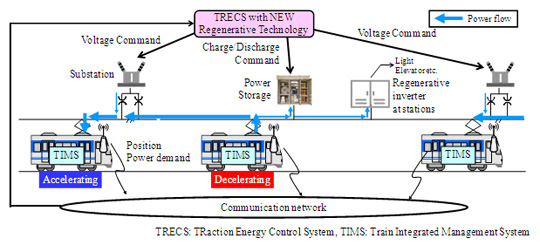News Release Archives
Note that the releases are accurate at the time of publication but may be subject to change without notice.
FOR IMMEDIATE RELEASE No. 2732
Mitsubishi Electric Develops Regenerative Power Optimization Technology for Railway Energy Saving
Reduces total railway energy consumption by up to five percent
TOKYO, February 14, 2013 - Mitsubishi Electric Corporation (TOKYO: 6503) announced today its development of a new technology that reduces total railway energy consumption by up to five percent through efficient use of regenerative power from trains and optimized voltage control at multiple railway substations. Commercialization is targeted at the fiscal year beginning in April 2014.
The technology enables full use of regenerative power in trains through real-time control of voltages at nearby substations. The five-percent reduction of total railway energy consumption was achieved in numerical simulations using a high-density urban railway model.

As an important transportation infrastructure, railway systems are facing the need to save energy given their high volume of electricity consumption. Currently, electricity generated when trains decelerate using regenerative brakes is reused by other trains that need to accelerate. Current regenerative systems, however, limit the amount of reused power when there is excess regenerative electricity or when there are few accelerating trains, because voltage distributed from substations is maintained at a high, fixed level to provide enough power to all trains even if they accelerate at the same time. As a result, a large amount of regenerative power is not utilized and is wasted as heat.

The new system controls the voltage distributed from substations based on train locations and acceleration/deceleration data collected from the train integrated management system (TIMS) of each train. The company's simulation shows that the new system reduces regenerative power wasted as heat in current systems by as much as 80%, and prevents voltage in feeding lines from becoming too high. Even if the amount of regenerative power becomes excessive, it can be fully utilized with power storage systems, such as batteries or regenerative inverters installed at stations.



Patents
Patents submitted for the technologies announced in this news release number one each in Japan and overseas.
As an important transportation infrastructure, railway systems are facing the need to save energy given their high volume of electricity consumption. Currently, electricity generated when trains decelerate using regenerative brakes is reused by other trains that need to accelerate. Current regenerative systems, however, limit the amount of reused power when there is excess regenerative electricity or when there are few accelerating trains, because voltage distributed from substations is maintained at a high, fixed level to provide enough power to all trains even if they accelerate at the same time. As a result, a large amount of regenerative power is not utilized and is wasted as heat.
The new system controls the voltage distributed from substations based on train locations and acceleration/deceleration data collected from the train integrated management system (TIMS) of each train. The company's simulation shows that the new system reduces regenerative power wasted as heat in current systems by as much as 80%, and prevents voltage in feeding lines from becoming too high. Even if the amount of regenerative power becomes excessive, it can be fully utilized with power storage systems, such as batteries or regenerative inverters installed at stations.

Patents
Patents submitted for the technologies announced in this news release number one each in Japan and overseas.